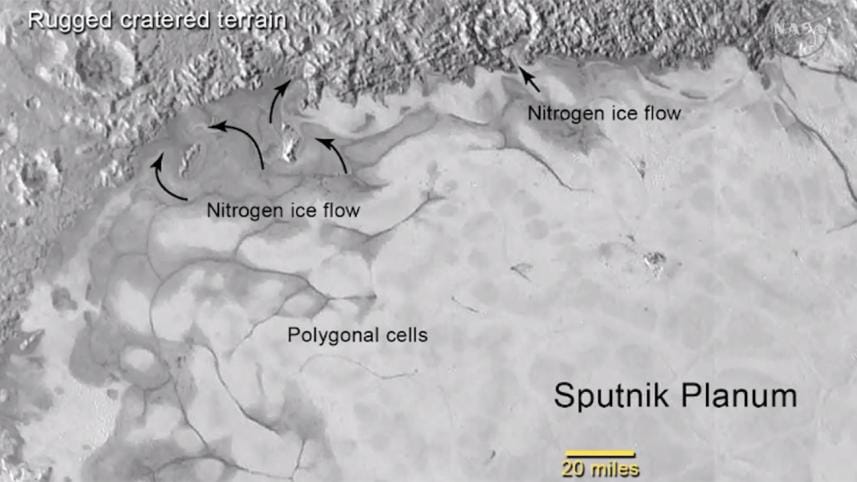Reason behind the mysterious heart on Pluto

NASA's New Horizons team — which sent the first spacecraft in history to fly over Pluto last week — revealed the latest set of Pluto mind-blowing images that came with some big surprsies and new mysteries, reports Business Insider.
Right now, the team is studying the most iconic feature on Pluto — the heart-shaped region informally called "Tombaugh Regio" shown in the lower right portion of Pluto in this high-resolution photo above.
This is the sharpest image yet of the dwarf planet as a whole that we've seen, and it reveals something that scientists hadn't been able to observe before: that the left lobe of Tombough Regio looks very different from the right lobe. It's more complete and colored-in.
Here's a close-up. These color photos reveal what Pluto would look like to the naked eye. They're created by combining images taken by the Long Range Reconnaissance Imager (LORRI) camera with information collected by the Ralph instrument.

And it's this latest find that scientists have used to provide the first prediction of what is generating the shape of Tombough Regio:
"Our interpretation is that material in the right lobe — the source for that material — is coming from the western [or left] lobe," said Alan Stern, who is the New Horizons principal investigator, during the NASA television announcement today.
Basically, NASA believes that there is some process on Pluto — possibly wind — that is transporting material from the left lobe across the surface and is then landing farther east to form the right lobe. This "mind-blowing" — as Stern puts it — false-color image highlights the difference between the two lobes nicely:

The team still suspects that the ligh-coloring of the feature could be coming from nitrogen snow, Stern added.
What's even more exciting are the latest close-up shots of the region informally called "Sputnik Planum," which is a smaller section toward the bottom of the Pluto's heart, carved out below. Sputnik Planum is about the size of Texas but it's completely different and could even have Earth-like glaciers:

Right now, the temperatures on Pluto's surface are around -380F which are too cold for water ice to flow. But nitrogen ice will melt at much colder temperature, -346 degrees F, which means it could go from a solid to a liquid on Pluto during warmer seasons.
As a result, this suggests evidence of glacier-like activity on Pluto's surface, the team reported. Geological activity was something the scientists had hoped to find but certainly were not expecting.
By zooming into that region on Pluto, the scientists pointed out clear evidence for this glacier-like activity, where the flat plains slam up against more rugged terrain. It appears that nitrogen could be flowing between the two different types of features, indicated by the patterns in the photo below:

"On Pluto, the kind of ices we think make up the planet — nitrogen ice, carbon monoxide ice — they will flow in the same way that glaciers do on Earth," said William McKinnon, who is the New Horizons co-investigator during the announcement. "To see evidence of recent geological activity is simply a dream come true." (By recent, McKinnon means within the last tens of millions of years, which is remarkable recent compared to the age of our solar system — 4 billion years.)
And as you move farther south toward the bottom of Sputnik Planum, there's a far more diverse surface as the plains meet some of Pluto's high mountain ranges. Here you can see the first two mountain ranges ever discovered on Pluto: Norgay Montes — similar in height to the Appalachian Mountains — on the right and Hillary Montes — similar to the Rocky Mountains — on the left.

The Norgay mountains were discovered just a few days ago and appear to be made of similar material as the Hillary mountains, which the team suspect could be water in ice form. Here's a close up of the Norgay mountains:

The atmosphere has a haze that stretches to as high as 100 miles above the dwarf planet's surface — 5 times higher than what the scientists were expecting.
After flying by Pluto, the spacecraft turned around and snapped a photo of Pluto as it eclipsed the sun, which highlights the haze as a bright ring around the tiny world:
According to Michael Summers, who is the New Horizons co-investigator at George Mason, this haze likely generates hydrocarbon compounds that are responsible for Pluto's red color.

"We don't understand why there's a hazy layer up to 100 miles altitude," Summer said. "It's a mystery that is one of the things we'll have to sort out in the coming days."
This latest data set adds to the library of information the New Horizons team is building on Pluto. And there's still a lot more to go. About 96% of the information that the New Horizons spacecraft has collected is still on board, and has not yet been transmitted to Earth.



 For all latest news, follow The Daily Star's Google News channel.
For all latest news, follow The Daily Star's Google News channel.
Comments